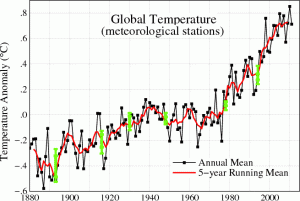When you look at that NASA GISS graph of temperature stations, one features jumps out: the flat-line beginning around WW2 and extending through the 70s. For awhile climatologists have suspected that was caused by relatively short-lived particulates that block/reflect sunlight, produced en masse by a big jump in industrialization for war production at the end of the Great Depression, perhaps aided by lots of burning cities and countryside. A new study confirms this:
(NPR) — Ben Booth, a climate scientist at Britain’s Met Office Hadley Center, says that aerosols create clouds. “The more aerosols you have, the more places there are for water vapor to condense,” he says. “And so what aerosols do is they cool.” They cool the ocean because clouds reflect sunlight back into space before it can hit the ocean.Volcanoes create aerosols, too, but air pollution appears to produce more, and then the aerosols sweep across the Atlantic sky. … “If you combine the role of volcanic activity and the human emissions of aerosols, we account for 76 percent of the total variation in sea surface temperature in our study,” Booth says. That’s a huge amount. Booth and his colleagues aren’t the first to propose that aerosols influence sea surface temperatures. But climate scientist Amato Evan at the University of Virginia says they’ve done the most thorough job to date of tracking and confirming those changes.
Remember that several right-wing climate change deniers like to maintain how ludicrous it is that humans could possibly change climate. Some even going so far as to suggest that God-eh would never allow that and decreed against it in the Old Testament. I’d be willing to bet those same clowns will find it suddenly plausible that humans can, after all, change the climate. But only when that change acts to cool the planet rather than warm it!
In the end, this effect won’t save us. Particulates have a short half-life, a few months, maybe a few years at best. The greenhouses gases that come with the particulates, like methane and carbon dioxide, persist for decades to millennia.


Maybe they are short lived, but this study is still incredibly useful, as it can be used to save the planet if things do get out of control. It means that we have the power to fix the problem, should it become a problem that needs our fixing.
So the Texas wildfires last year were just god trying to help us with global warming.
Those idiot firefighters, trying to thwart god’s will!
“it can be used to save the planet if things do get out of control. It means that we have the power to fix the problem, should it become a problem that needs our fixing.”
Really? It’s not just that the pollutants are short-lived; they are also regional. You would have to pollute the entire planet, not just the areas that are currently polluted.
Also, there were very good reasons for the Clean Air Act that acted to remove some of those pollutants; they really aren’t all that good for us, or for wildlife. They did a lot of harm.
This is NOT an answer to the problem. The idea of using pollution to fix global warming is just another example of narrow thinking – solve one problem by creating another. Until we recognize the complexity of the problem, we’ll keep coming up with simple solutions that really won’t fix it, and will mess up everything else.
Lorax, geoengineering to put aerosols into the atmosphere wouldn’t ‘solve’ the problem, as the post says, “this effect won’t save us. Particulates have a short half-life, a few months, maybe a few years at best. The greenhouses gases that come with the particulates, like methane and carbon dioxide, persist for decades to millennia.” It might ameliorate or mask it temporarily. Even if you could engineer a particulate machine that just blows smoke without the attendant CO2, you’d still have industrial society pumping out CO2, and as soon as you turned off the particulate stream, you’d be back at CO2 at 400ppm, or 450 ppm, or where-ever we would be then. Plus, and maybe the study addresses this, I haven’t read it, during the period in question, we were at about 315 ppm CO2, now we are ~385 ppm, is it a linear response between aerosols versus CO2 and cooling? How much more aerosols would we have to put into the atmosphere today? And, it wouldn’t do a thing to reduce the other effects of the increasing atmospheric CO2, like ocean acidification, plus, the aerosols also have other side effects.
I’ll ask a buddy, but my understanding is it’s Faustian bargain, the aersols are logged and quickly asymptote. The particulates are already overwhelmed, that’s why temps jumps hard in the 70s and have climbed since despite massive aerosol production compared to 1940 levels. Short of practically blacking the sun out with reflective dust, it won’t work anymore.
Er, no. Apart from the points others have already made, there is the other problem caused by carbon dioxide emissions: acidification of the oceans. This may turn out to be just as serious as rising temperatures, and aerosols do nothing to mitigate it.